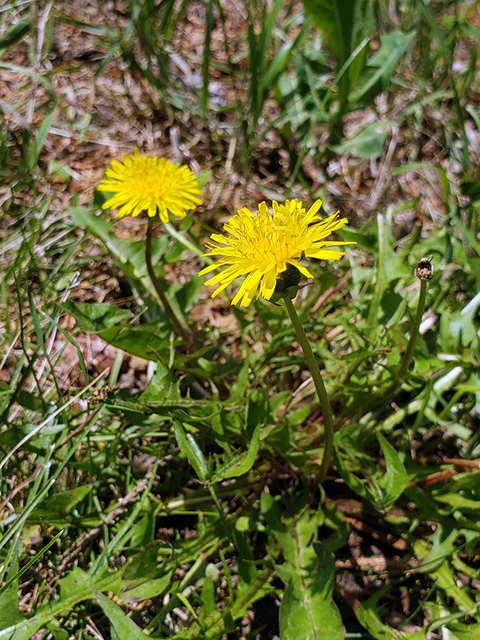Quick facts
- Dandelions are aggressive, perennial weeds that thrive in hot, moist conditions.
- Dandelions can be identified by their bright yellow flowers, hollow, leafless stalks, and the formation of “puffballs” when they go to seed.
- Removing the entire taproot is essential for hand pulling.
- Apply herbicides in the late summer through the fall when dandelions move nutrients and herbicides into their roots to prepare for winter.
Characteristics
Dandelions in Minnesota consist primarily of two different species: common dandelions (Taraxacum officinale) and red-seeded dandelions (Taraxacum erythrospermum). Both species are perennial members of the Asteraceae family (asters and daisies) and are treated the same in landscapes.
Typically growing between 3 inches and 2 feet, dandelions can survive harsh conditions due to their deep taproot. Dandelions can spread easily due to their abundant parachute-like seeds.
Flowers, fruit and seeds
- Bloom Time: early spring to fall.
- Dandelions have bright yellow flowers with many small petals (ray florets).
- Red-seeded dandelions have slightly smaller flower heads than common dandelions.
- Seeding dandelions are characterized by their “puffball” shape, consisting of multiple seeds (cypsela) connected to “parachutes” (pappus) by long stalks (beak).
- Red-seeded dandelions can be identified by their red seeds compared to common dandelions with green or brown seeds.
Leaves
- Lance-shaped leaves form at the base of the stem in a circular cluster.
- Dandelion leaves are deeply lobed and form points angled toward the stem.
- Red-seeded dandelion lobes are typically deeper, and points are more pronounced than those of common dandelion.
- Dandelion leaves are hairless and have white sap.
Stem and roots
- Stalks are hollow and contain white sap when broken.
- Dandelion stalks do not branch, have no leaves, and only produce one flower.
- Dandelions have a deep branching taproot reaching from 6 inches to 2 feet deep.
- New plants can form from broken-off root sections.
Where it thrives
Dandelions thrive in thin lawns, garden beds, and disturbed soils rich in nitrogen and potassium.
Although dandelions have increased growth in full sun and moist conditions, they are adaptable to many different environments.
Dandelions can indicate compaction and low calcium in soils.
Control and management
Dandelions grow deep taproots capable of producing new plants from root sections.
Turf
- Hand removal is effective for removing individual plants or small patches.
- Remove as much of the root as possible to prevent regrowth.
- A dense and healthy turf is the best defense against dandelion encroachment.
- Mowing dandelions before seeding reduces spread via seed dispersal but does not stop the growth of existing plants.
- Chemical control of dandelions should be done in the late summer and early fall, although spring applications can also be effective.
- Dandelions move nutrients and herbicides into their root systems in the fall to prepare for winter.
- Post-emergent herbicides:
- 2,4-D
- MCPA
- Dicamba
- Triclopyr
Garden
- Hand removal is effective for removing individual plants or small patches.
- Remove as much of the root as possible to prevent regrowth.
- Post-emergent broadleaf herbicides effective on dandelions growing in turf are also effective on dandelions growing in a garden.
- Herbicides also damage desired plants in a garden.
- Mulching can be beneficial in reducing seed germination.
Benefits to the landscape
Dandelions can amend compacted soils by bringing nutrients to the surface with deep taproots. The weed’s deep taproot is also able to aerate compacted soils.
The quality of dandelion nectar and pollen for pollinators is argued; however, their early spring bloom and adaptability to harsh conditions can provide nectar and pollen sources to pollinators when other sources are unavailable.
Dandelions are full of nutrients and are used in many chef’s kitchens and in traditional medicines.
Conservation, invasive status and native status
- Introduced.
- Dandelions are native to Europe and were originally brought to the United States in the 1600s as an edible and medicinal plant.
Plants that look similar
- Common catsear
- Chicory
- Perennial sowthistle
CAUTION: Mention of a pesticide or use of a pesticide label is for educational purposes only. Always follow the pesticide label directions attached to the pesticide container you are using. Be sure that the area you wish to treat is listed on the label of the pesticide you intend to use. Remember, the label is the law.
Burley, N. (2022, June 16). Foraging at home: Can I eat the weeds in my backyard? Yard & Garden News. https://extension.umn.edu/yard-and-garden-news/can-i-eat-weeds-my-backyard
Cudney, D. W., & Elmore, C. L. (2006, July). Dandelions. Pest Notes. https://www.maine.gov/dacf/php/gotpests/weeds/factsheets/dandelions-cal.pdf
Mahr, S. (n.d.). Dandelion, Taraxacum officinale. Wisconsin Horticulture. https://hort.extension.wisc.edu/articles/dandelion-taraxacum-officinale/
Michigan State University. (n.d.). Dandelion. Department of Plant, Soil and Microbial Sciences - Weeds. https://www.canr.msu.edu/weeds/extension/dandelion#:~:text=Dandelion%20plants%20thrive%20on%20soils,poor%20decay%20of%20organic%20matter
Reviewed in 2024


